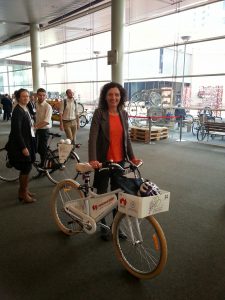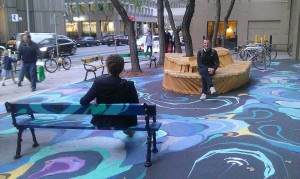Ko Te Kai a Te Rangatira – Ko te kai a te rangatira, he korero
(The sustenance of leaders are conversations)
Ko te tohu o te rangatira, he manaaki
(The mark of leaders is generosity)
Ko te mahi a te rangatira, he whakatira i te iwi
(The work of leaders is to unite the people)
This report covers my Waitematā Local Board activities during May 2014 as Deputy Chair, lead for the Community and Transport portfolios, Chair of the Grants Committee, Deputy Chair of the Central Joint Funding Committee and with positions on the Ponsonby Business Association and Ponsonby Community Centre Committee.
Portfolio Report: Community
Community Grants
The Waitemata Local Board Community Grants Committee met in May to consider applications to the fourth and final round of the 13/14 community grants fund.
The recommendations of the committee are on the June agenda of the Waitematā Local Board.
Housing
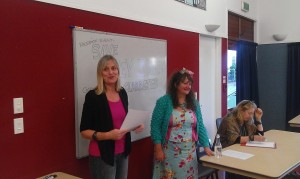 In May we were able to celebrate the decision by Council and the Government to not include Spring St pensioner housing in the list of Special Housing Areas that would have allowed for fast track development (and resulted in the eviction of elderly tenants who were guaranteed a flat for life when the housing was bought from the old Auckland City Council).
In May we were able to celebrate the decision by Council and the Government to not include Spring St pensioner housing in the list of Special Housing Areas that would have allowed for fast track development (and resulted in the eviction of elderly tenants who were guaranteed a flat for life when the housing was bought from the old Auckland City Council).
It was also a win of sorts that, with the support of the Board, the Great North Road ridge was declared a Special Housing Area but unfortunately too late for the Arch Hill residents who are fighting the big box Bunnings development.
However as was discussed at the public meeting I attended on 10 May (facilitated by Board member Deborah Yates) there is still a great deal of uncertainty and anger about HNZ’s current approach to removing tenants which will have a big impact on the diversity our community.
Other issues relevant to the Community portfolio
A range of meetings were attended during May relevant to the Community portfolio – these are listed below.
Portfolio report: Transport
Upper Queen Street Bridge – Grafton Gully cycleway connection
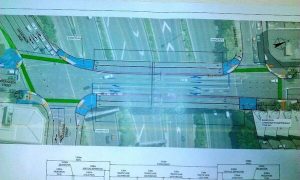 Earlier this year we discovered that the City Centre Transformation team were not looking to deliver the connection between the Grafton Gully cycleway and Ian McKinnon Drive on the Upper Queen Street bridge until 15/16 despite the cycleway being due to be opened by NZTA in September this year (and despite a budget being available for the project)
Earlier this year we discovered that the City Centre Transformation team were not looking to deliver the connection between the Grafton Gully cycleway and Ian McKinnon Drive on the Upper Queen Street bridge until 15/16 despite the cycleway being due to be opened by NZTA in September this year (and despite a budget being available for the project)
Fortunately the escalation of this issue has had results and the good news is that the connection will be ready in time! After reviewing the design (right) the transport portfolio has requested a drinking station be incorporated, that pedestrians/riders have priority phasing of the lights and that all steps be taken to ensure way finder signage is installed in time for the opening
Legible Auckland
I continue to log requests for pedestrian signage on streets with NO EXIT signage that in fact have walkway access.
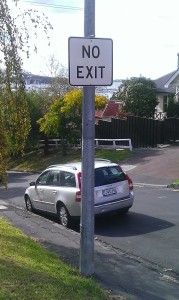 Auckland Transport has confirmed the following streets will receive “walkway” signs:
Auckland Transport has confirmed the following streets will receive “walkway” signs:
- Sheridan Lane, Freemans Bay
- Gwilliam Place, Freemans Bay
- Pratt Street, Freemans Bay
- Samoa House Lane
- Sylvan West Avenue (Albert – Eden Local Board area)
- Cheshire Street, Parnell
- Wharf Road, Herne Bay
- Bayfield Road, Herne Bay
- Prosford Road, Ponsonby
There are still many signs on poles that need to be updated with the correct walkway information such as this one on St Marys Bay road.
Auckland Transport Parking Discussion Document
The consultation on Auckland Transport’s parking discussion document went live on 31 May and will be open for feedback until the end of June.
For more on the parking issues and the parking strategy proposed by Auckland Transport refer “Getting Parking Right for Auckland”
Monthly transport update
A monthly update with Auckland Transport took place on 21 May. Current issues are reported back monthly by Auckland Transport on our public agenda including the details of the consultation undertaken with the Transport portfolio on behalf of the Board.
Other board activities
Local Board Plan
During May I have been assisting with finalising our draft Local Board Plan that will go out for consultation on 7 July (the draft is on our June agenda). I’ve also been working on a very exciting event for the launch of our plan. Details will be available shortly.
Janette Sadik- Khan visits Auckland
 A big highlight of May was Janette Sadik-Khan’s visit to Auckland. The transport revolutionary presented “Designing Streets for People” to a record breaking Auckland Conversation audience. How the streets of New York were transformed while she was NYC commissioner of transportation from 2007 – 2013 under Mayor Bloomberg, is an amazing story and provides a great deal of inspiration for what we can achieve in Auckland.
A big highlight of May was Janette Sadik-Khan’s visit to Auckland. The transport revolutionary presented “Designing Streets for People” to a record breaking Auckland Conversation audience. How the streets of New York were transformed while she was NYC commissioner of transportation from 2007 – 2013 under Mayor Bloomberg, is an amazing story and provides a great deal of inspiration for what we can achieve in Auckland.
Best of all she had time for a Frocks on Bikes ride after doing a walkabout with the Mayor.
Workshops and meetings
In the period 1 May – 31 May I attended:
Effective Meetings for Local Board Chairs and Deputy Chairs – a very useful session looking at styles and approaches that help meetings to run smoothly and generate decisions.
- Local Board workshop on 6 May
- Community Development portfolio discussion on 6 May
- Presentation to PBA members on the feedback received on the draft Ponsonby Road master plan on 7 May
- Site visit for the Cowie Street Road Extension / Newmarket Level Crossing project (Parks and Transport portfolios) on 8 May
- Meeting with Ashley Church, Newmarket Business Association
- Local Government New Zealand Zone 1 meeting in Whangerei on 9 May
- Housing public meeting at the Grey Lynn Community Centre on 10 May
- Meeting with Alan Pack regarding a new underpass design for the Newmarket Level Crossing
- Communications meeting on 12 May
- Attended the St James Theatre site visit with the Mayor and Councillors (ahead of the governing body’s confidential agenda item on the future of the St James)
- Open Streets Initiatives in NZ The gateway drug for walking, cycling and connecting communities– watched the webinar with Christopher Dempsey and Vernon Tava
- Catch up with Heart of the City
- Briefing: Downtown Shopping Centre Block Re-development Future Options for Queen Elizabeth Square Report on 13 May
- Meeting with Luka Hinse regarding a Pecha Kucha collaboration for launching the local board plan
- Auckland Transport parking strategy workshop for elected representatives on 13 May
- Planning meeting for Local Board plan pop-ups
- Waitemata Local Board business meeting at Parnell on 13 May
- Briefing on Pioneer Womens Hall on 14 May
- Catch-up with Alex Williams, SBN to discuss Project NZ and social enterprise in Waitemata
- Ponsonby Road master plan meeting
- Meeting to go over feedback on the draft local board plan
- Auckland Development Committee workshop re Downtown Shopping Centre redevelopment & Waitemata Local Board
- Waitemata Local Board workshop on 17 May
- Local Economic Development workshop with Councillors and Local Board members
- Central Joint Funding Committee Workshop – Auckland City Cultural Heritage Fund applications
- Meeting to sign off on Waitemata Local Board plan
- Maori Responsiveness training for elected members on Te Kai-A-Te Rangatira: Building relationships with Māori – a forum for elected members to raise questions, share ideas and converse with Council’s subject matter experts (I learnt the Whakatauki that starts my report at this session)
- Meeting to discuss community-led place making with Parnell Community Committee (part of my Community-led development champions work stream) on 19 May
- Meeting to approve the draft local board plan to be attached to our June agenda
 Waitemata Local Board workshop on 20 May
Waitemata Local Board workshop on 20 May- Meeting with Auckland Transport, Auckland Council, Bunnings and Arch Hill representatives regarding a proposal to remove the kerb extension on King Street
- Ponsonby Business Association Board strategic planning session
- Monthly transport portfolio meeting on 21 May
- Mayoral Tour on 21 May including a visit to Pt. Erin Pools (photo right) and Art Station
- Waitemata Local Board update Briefing from Waterfront Auckland
- Meeting to finalise Local Board Plan summary
- Waitemata Local Board Grants Committee meeting on 22 May
- Auckland Transport’s public meeting on the Cowie Street bridge/Sarawia underpass at Jubilee Hall, Parnell on 22 May
- Community place-making champions group meeting on 26 May
Events and functions
In the period 1 May – 31 May 2014 I attended:
 Cycle Action Auckland’s Associates Breakfast at the Auckland Art Gallery on 1 May
Cycle Action Auckland’s Associates Breakfast at the Auckland Art Gallery on 1 May- First Thursday on K’rd and K’rd and Newton Plans drop in session
- POP project 02 / The Park / blessing of the hives in Victoria Park on 3 May
- Judge for the regional New Zealand Environment Entrepreneurs on Sunday 4 May
- Fair Trade Auckland event at Ponsonby Central (photo right)
- Plastic bag Free Auckland meeting held at the Grey Lynn Community Centre
- Te Kanano mobile ap launch at AUT
- Artist Studio opening at 3 Ponsonby Road on 9 May
- On Saturday 10 May visited the craft fair at Art Station, Station Square market, tree planting at Waipapa Stream with Parnell Heritage, members of the Board and community ; attended a Fair Trade afternoon tea, the Ponsonby Cruising Club Art Auction exhibition and popped into the Pollen Hotel Workshop part of POP Projects 02: The Park
- Launch of GridAKL, Wynyard Quarter on 16 May
- Auckland Writers Festival event
- TRENDZ conference launch, Viaduct Event Centre, hosted by ATEED
 Velo –City conference meet- up for attendees from Auckland
Velo –City conference meet- up for attendees from Auckland- Gathering for Janette Sadik-Khan sponsored by MR Cagney on 23 May
- Taste Ponsonby – Ponsonby Primary fundraiser on 23 May
- Popped into HACK AKL at AUT and the mini music festival on Lorne Street for NZ music month on 24 May
- Frocks on Bikes ride with Janette Sadik-Khan
- Auckland Conversation presentation by Janette Sadik-Khan (NYC, Commissioner for Transportation 2007-2013) followed by dinner hosted by the Mayor
- Velo-City Global 2014 Celebration of Cycling, Adelaide 27 -30 May (conference report back Attachment B)
- Place making workshop with Ethan Kent on 30 May (to be reported back next month)



